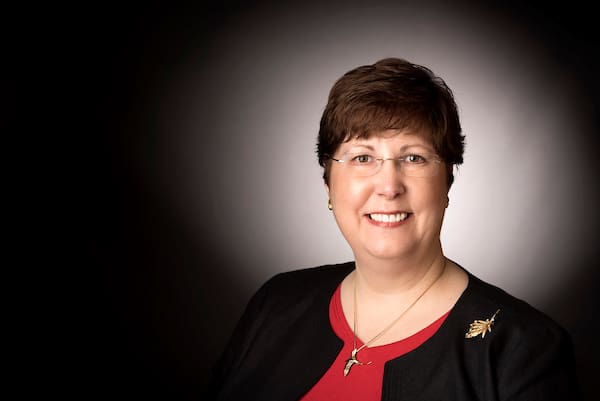Women to Watch at UA Little Rock: Dr. Johanna Miller Lewis

In celebration of Women’s History Month, UA Little Rock is profiling women in leadership positions who are making a difference at the university and in the community.
The first Woman to Watch at UA Little Rock of 2024 is Dr. Johanna Lewis Miller, associate dean for curriculum and student success in the College of Humanities, Arts, Social Sciences, and Education!
Tell us about yourself and your background.
I’m a native of Baltimore, Maryland, the youngest of three children, who traveled south for higher education and never returned home. I lived in Winston-Salem, NC, for six years when I earned my BA in American Studies and History at Salem College (for women) and my MA in U.S. History with a concentration in Historic Preservation at Wake Forest University.
Fun fact about me: after 12 years of all-female education, I married the first man I met at Wake Forest! After we both got our master’s degrees at Wake Forest, we moved to Williamsburg, Virginia, where I pursued my Ph.D. in Early American History at the College of William & Mary, and worked at Colonial Williamsburg.
What is your current position and professional duties at UA Little Rock
I’m Associate Dean for Curriculum and Student Success in CHASSE. I supervise the folks in our Student Success Center and monitor all curriculum changes in the college. I also deal with student problems and complaints, and answer questions on how to get things done from chairs and faculty. When I’m not doing that, I am interim chair of World Languages!
What brought you to UA Little Rock?
I came to UA Little Rock in 1991 as Assistant Professor of History and Assistant Coordinator of Public History. Funny story, I was not hired to teach Early American History because the department already had Charlie Bolton, an early American historian. Instead, along with U.S. History, I taught courses about museums for the Public History graduate program, and my favorite course Material Culture, which teaches students how to use objects as primary documents.
What are some of the exciting projects that you are working on at UA Little Rock?
My days of exciting projects are over, but I did a lot of Public History projects in the community between 1994-2004. The Dunbar Project preserved the history of Paul Lawrence Dunbar High School, the segregated high school in Little Rock from 1929-1955. I worked with alumni from the school to create an archive, do oral history interviews, and curate a traveling exhibit about the school.
The Dunbar project got me into working on the 40th anniversary of the Central High Crisis in 1997, and my students did the research for the first introductory exhibit on the crisis, which was in the old Mobil/Magnolia gas station across from the high school. We also staffed the museum for the first four months it was open. I researched the exterior of that building so it would appear as it did in September 1957. I continued to work for the Central High Museum as it transitioned to become part of the National Park Service and did the research and wrote most of the exhibit in the current Visitor Center.
My last Public History project was the largest: Life Interrupted: The Japanese American Experience in World War II Arkansas. This project was funded by the Winthrop Rockefeller Foundation and endeavored to teach Arkansans and Americans about the two War Relocation Centers located in the Delta during World War II. I led the project for four years from 2000-2004 as we partnered with the Japanese American National Museum in Los Angeles, California. We created a big exhibit about the history of Rohwer and Jerome at the Convention Center that now anchors the Japanese American Internment Museum in McGehee. We also had exhibits in the Fine Arts Building on campus and the MacArthur Museum of Arkansas Military History down. I’m particularly proud of a documentary “Time of Fear,” produced by the project that aired nationally on PBS. After Life Interrupted ended, I continued to coordinate some grants from the National Park Service to conserve and restore the cemetery at Rohwer.
What woman has inspired you the most and why?
Elizabeth Steele, a mother (twice married), tavern keeper, mistress to apprentices, and patriot in the backcountry of colonial North Carolina. Working women, and especially mothers who work, were not a 20th century innovation. Elizabeth Steele did it all, and managed to have opinions about the Revolution. Her second child, John, served as Comptroller of the Currency under U.S. President John Adams.
What advice would you give to the next generation of female leaders?
Do not let anyone tell you that you can’t do something you want. You are in control of your life—no one else.
Name something about yourself that most people would be surprised to learn.
I spent a summer in costume at Colonial Williamsburg educating people about how cabinetmakers built furniture in the 18th century.
What is your favorite quote and why?
Carpe Diem – Latin for “seize the day.” I like the reminder to live each day to the fullest because you never know what tomorrow will bring. I always told my husband “I love you,” whenever I said goodbye to him; that provided me with great comfort when he suddenly died.
Is there anything else you’d like to add?
I’m retiring at the end of June, and it has been my absolute privilege to work at UA Little Rock.
